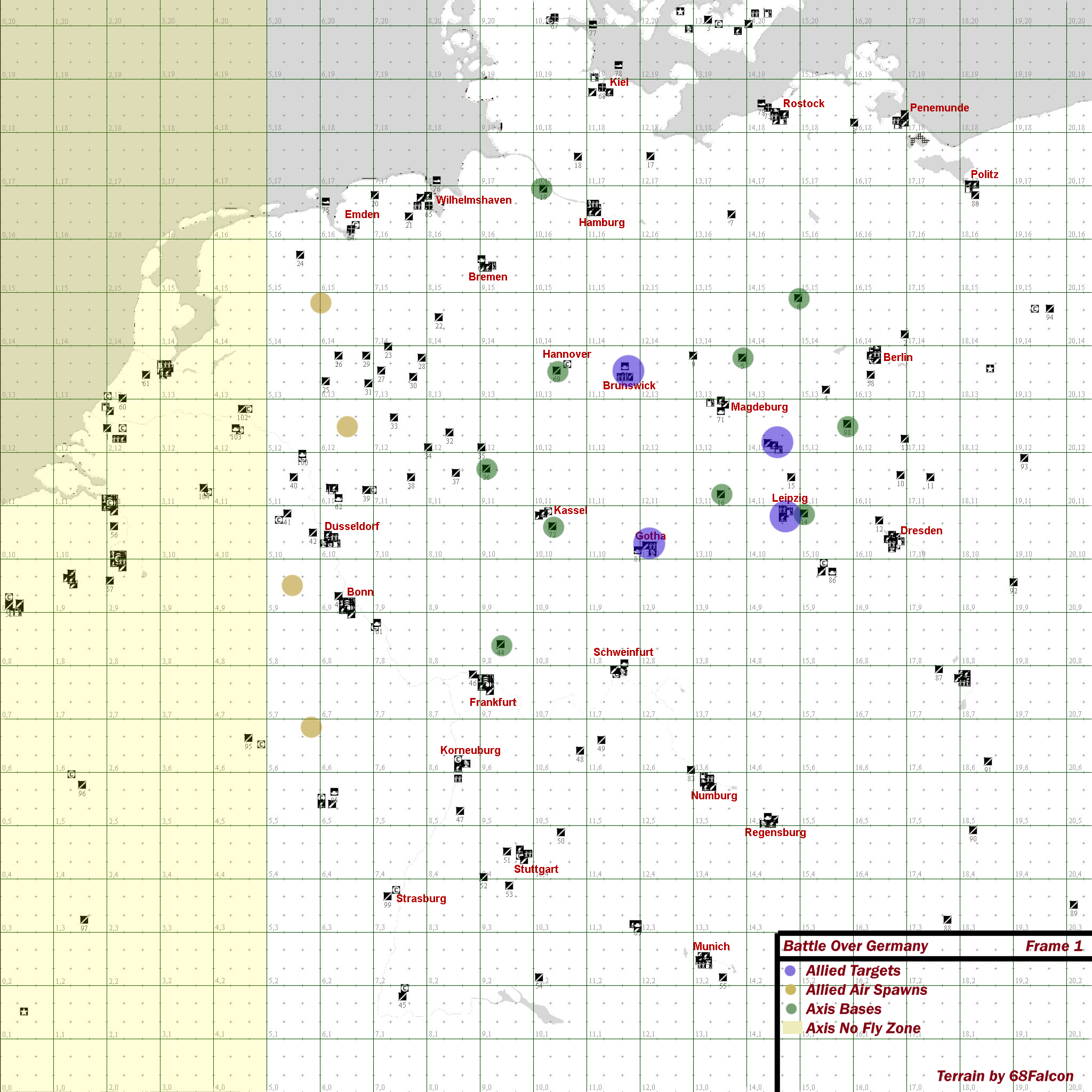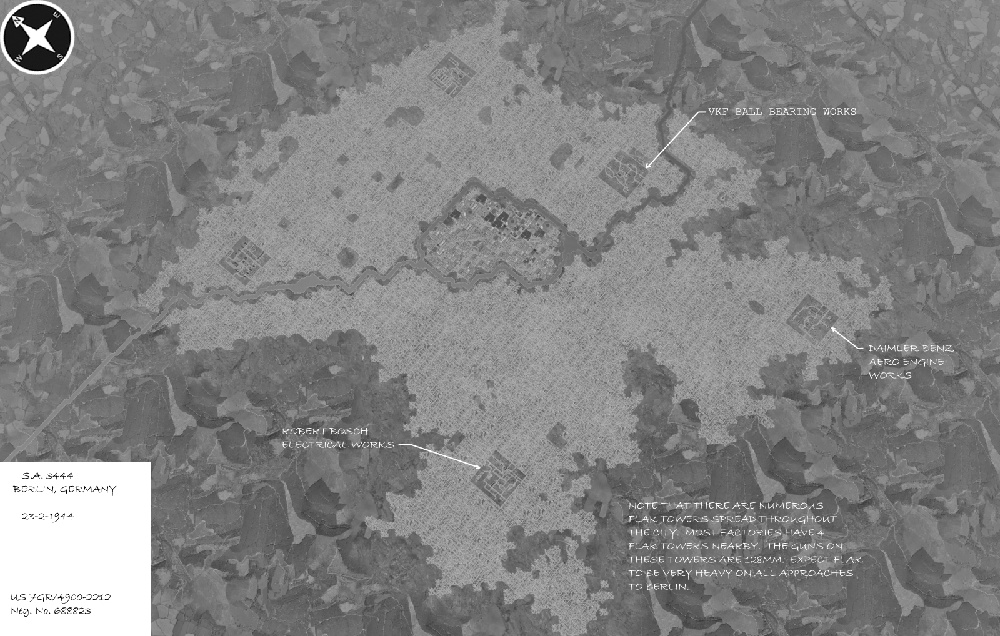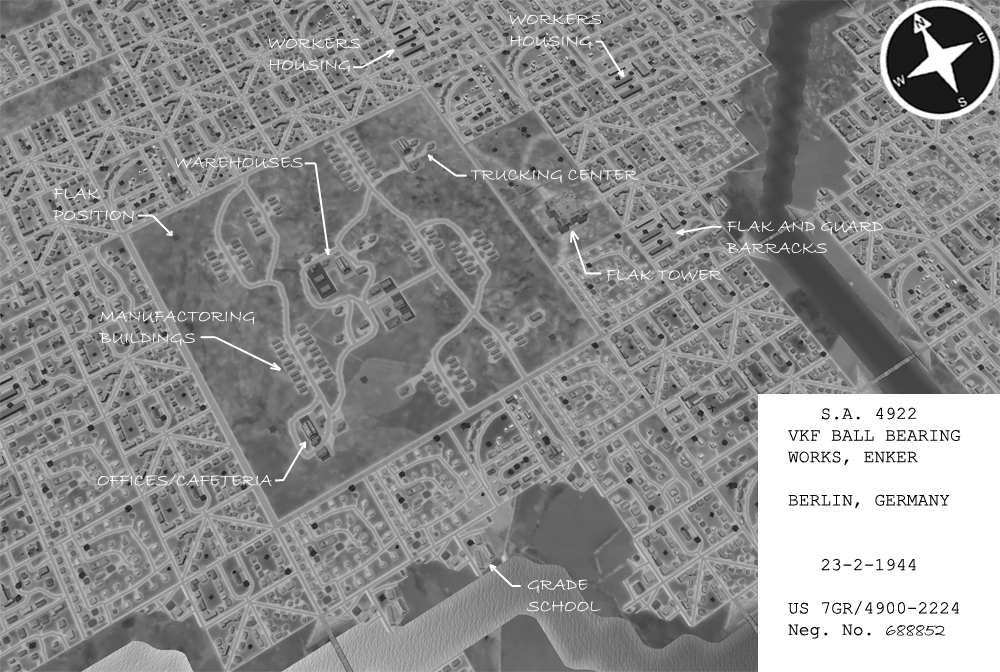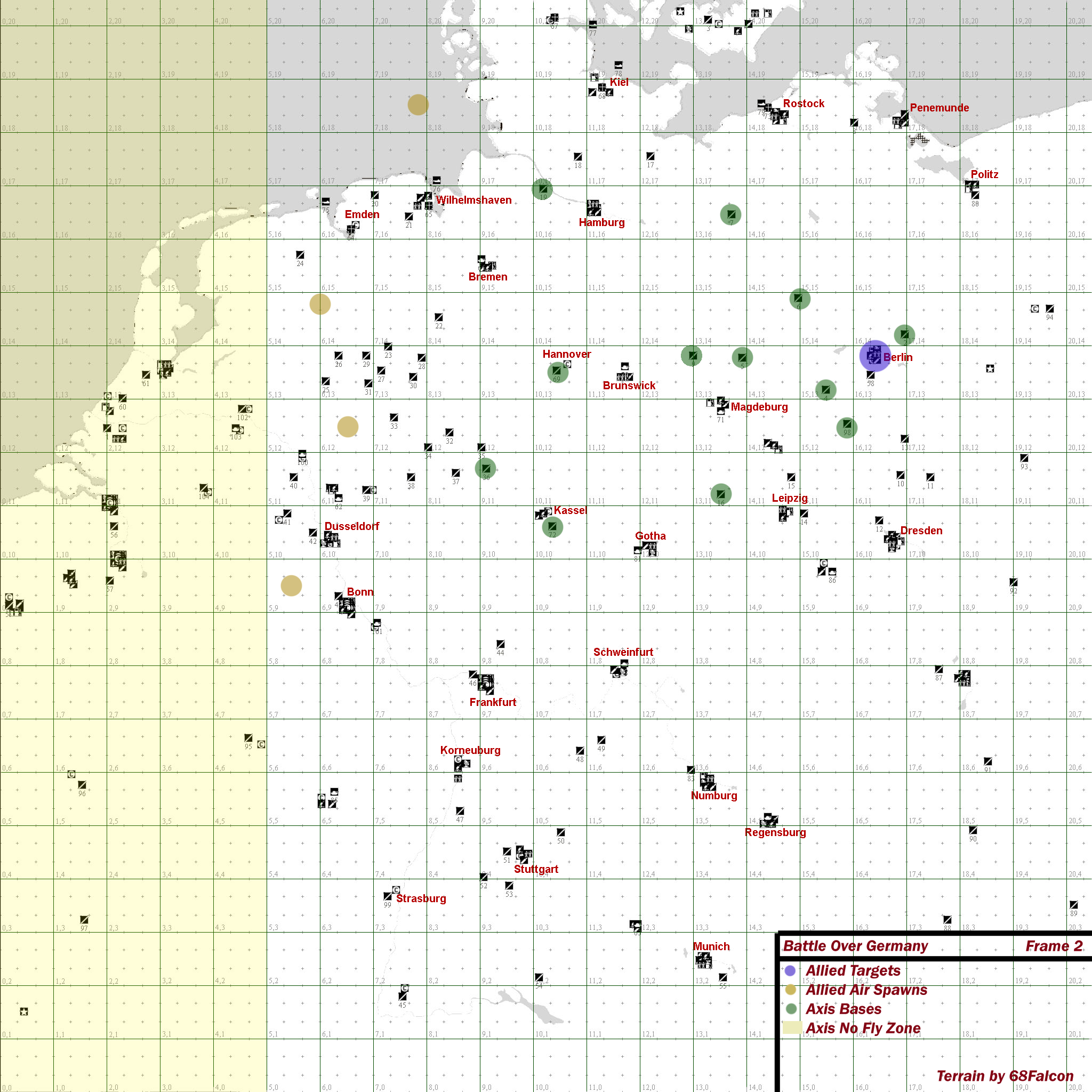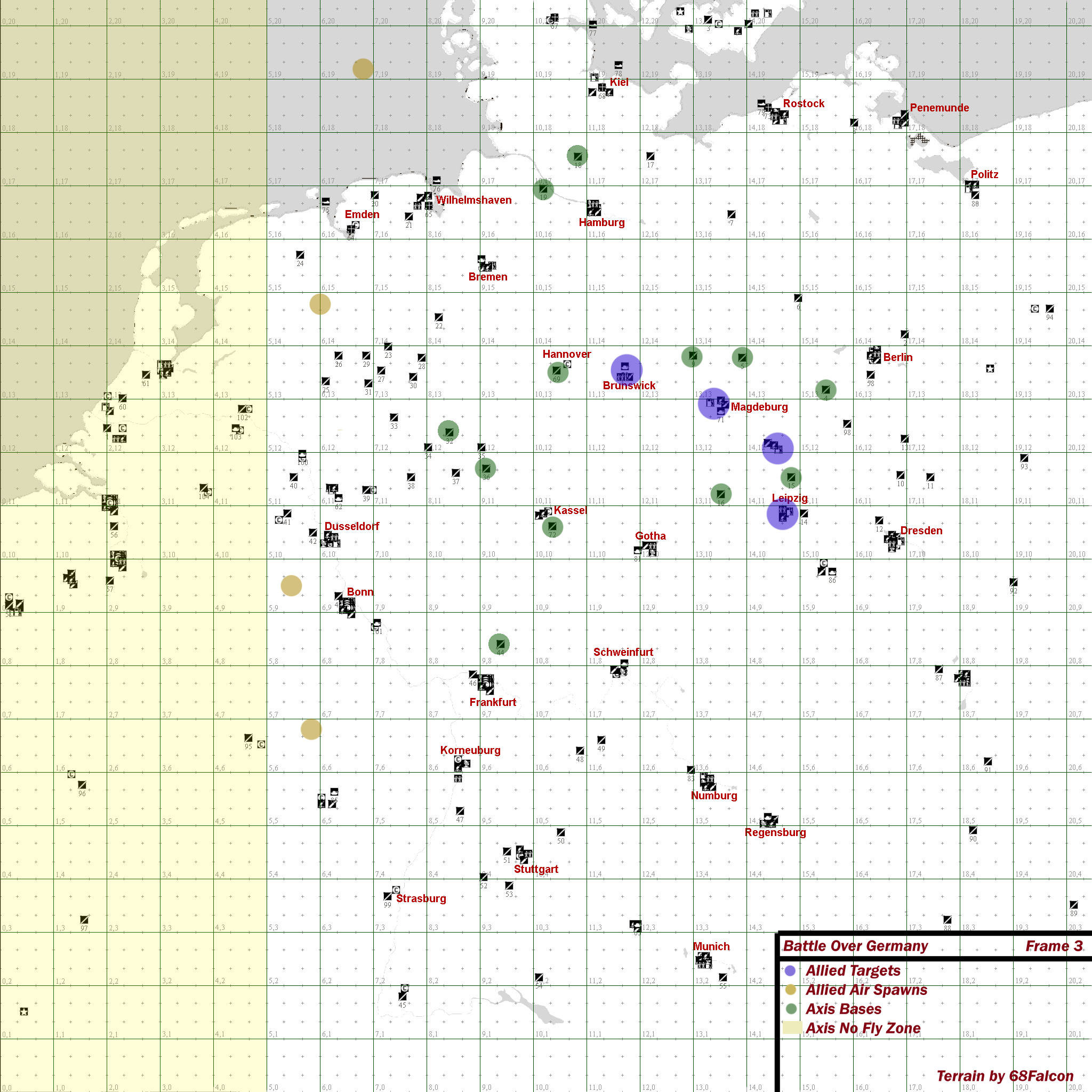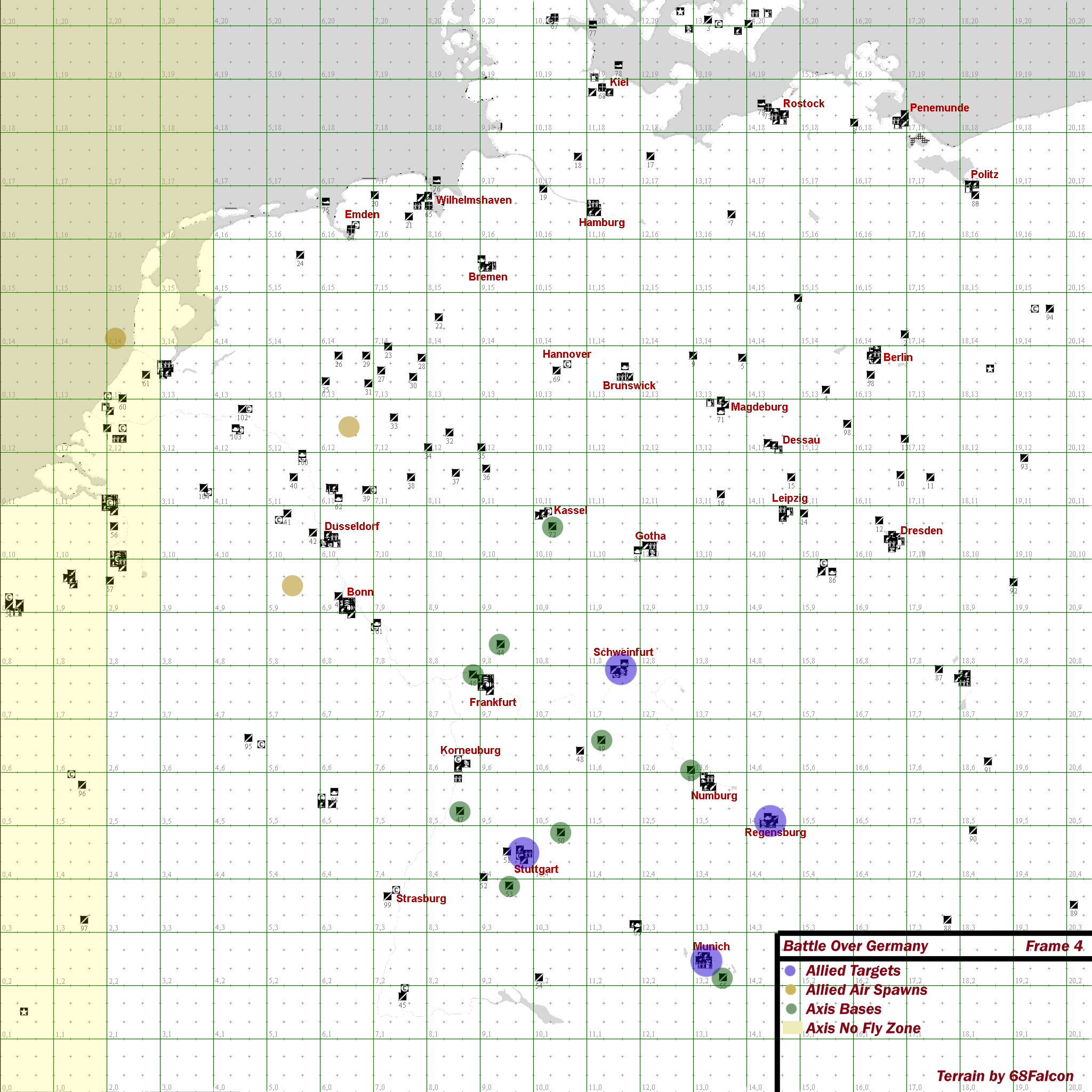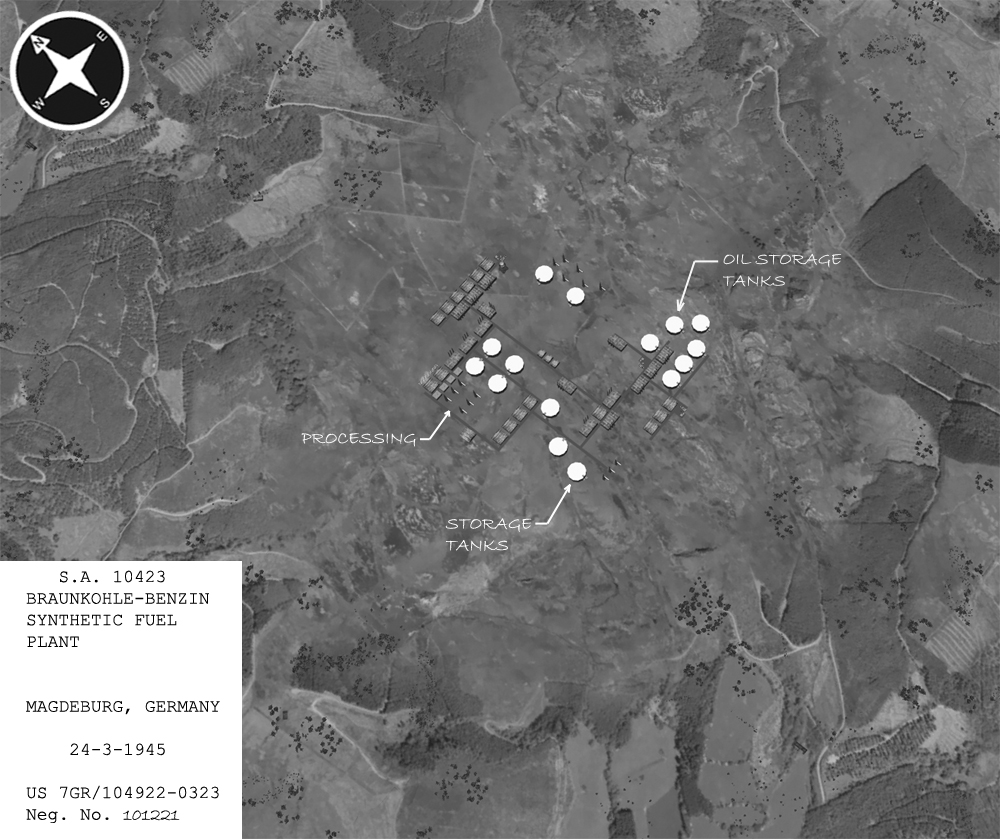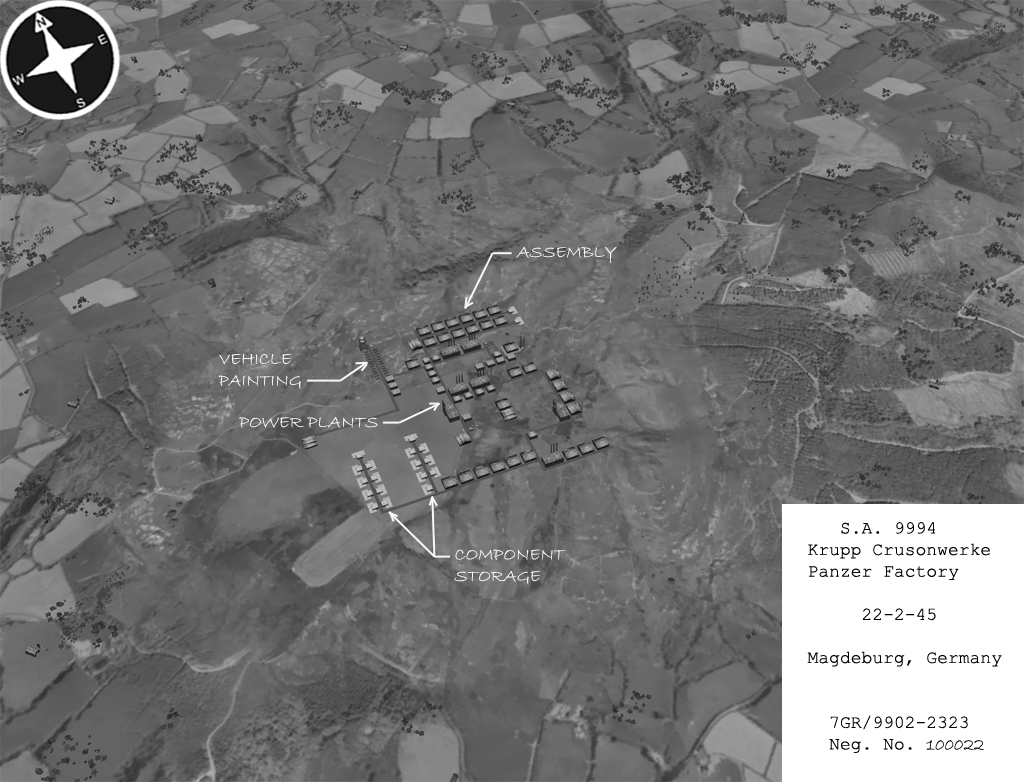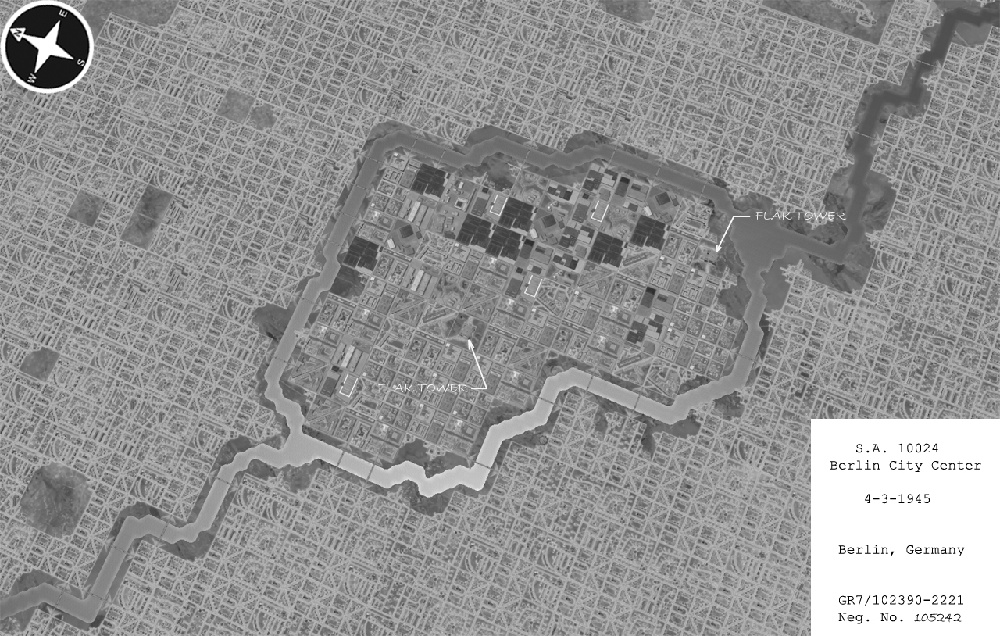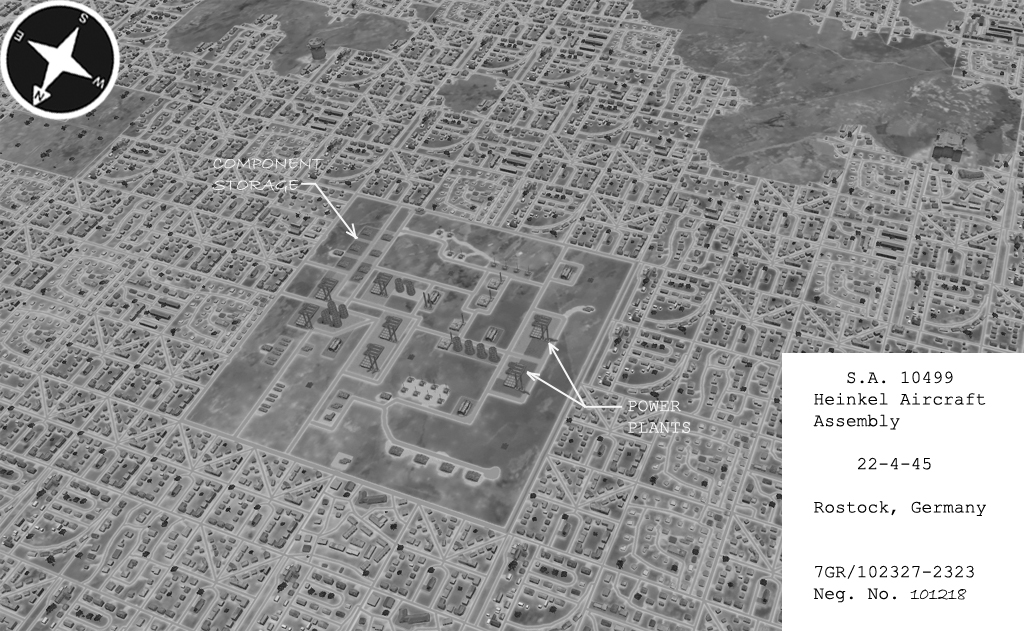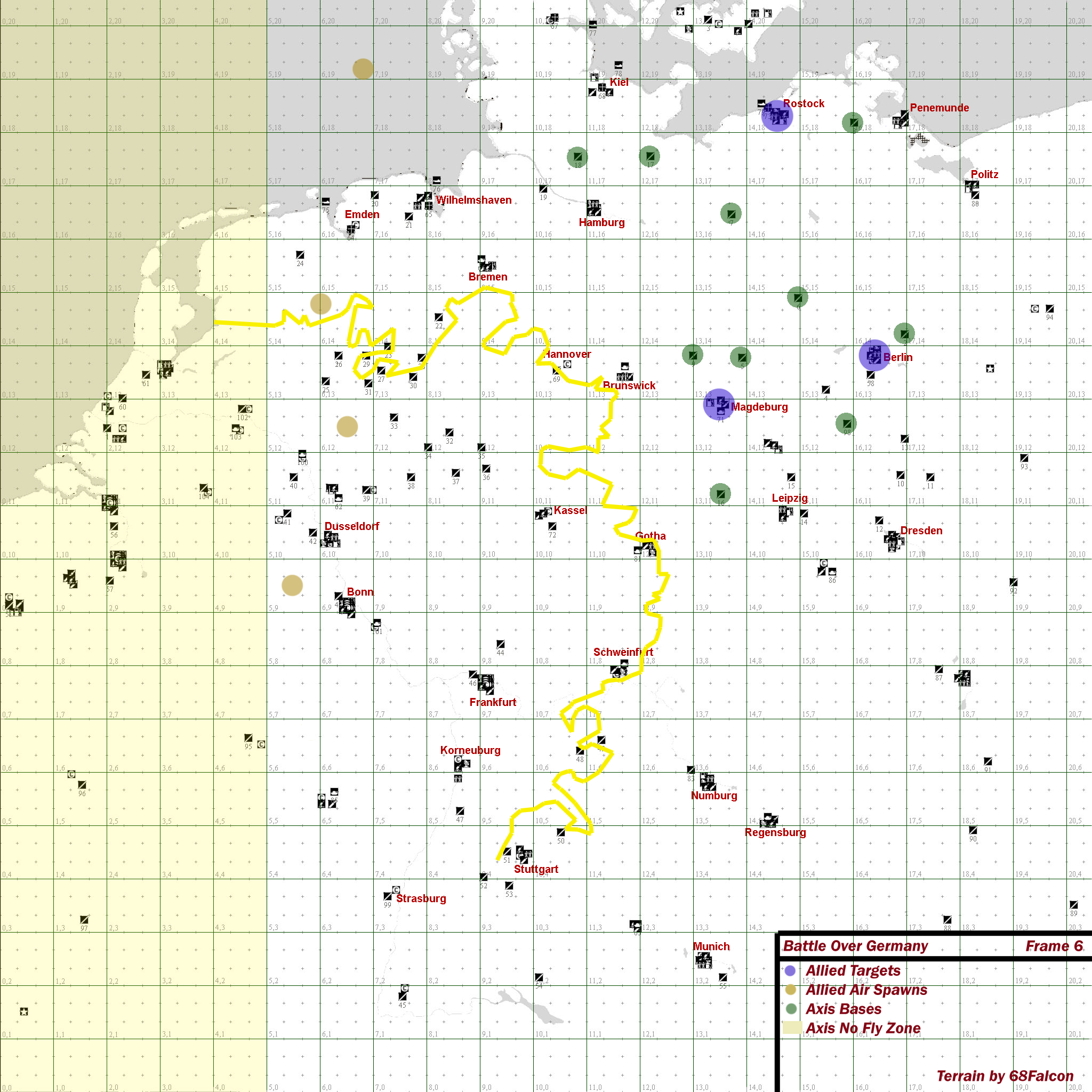Battle Over Germany '11
Battle Over Germany
Final Version
- Introduction
- Dates and Times
- Summary of Rules
- Base Map of Germany Terrain
- Historical Context
- Victory Conditions
- Summary of Constraints
- Order of Battle
- Where History Comes Alive
- The Battle Over Germany
- Frame 1 - February 20, 1944
- Frame 2 - March 6, 1944
- Frame 3 - May 28, 1944
- Frame 4 - July 21, 1944
- Frame 5 - November 2, 1944
- Frame 6 - April 7, 1945
- Settings
- For CM's
- References
- Designer Historical Notes
- Credits and Thanks
Table of Contents
Introduction
This is the classic fight of the 8th Air Force versus the Luftwaffe. Experience the air war over Germany in six historical missions ranging from February 1944 to April 1945. Be a member of the unit of your choice. Use the planes they did for each mission and see how the battle over Germany evolved. Fight the dynmaic fight against the opposition as both you and they evolve in strategy and equipment. Join up and fight the last 14 months of the war in the skies over Germany.
Historical Context
January 1944 - The Situation.
The Eighth Air Force
The US Eighth Air Force started its strategic bombing campaign on German occupied Europe with an attack by 12 B-17s on railway yards at Rouen France in July 1942. From that point forward the size of the Eighth Air Force grew as more and more Groups were added. For the remainder of 1942 the attacks were confined to France and Belgium. In January 1943 the first large scale daylight attack on a target in Germany occurred when 64 B-17s and B-24s attacked Wilhelmshaven on Germany's north western coast. Over the next few months the attacks went gradually deeper and deeper into Germany.
The crescendo reached its peak on August 17, 1943 when 363 B-17s attacked the ball bearing works at Schweinfurt and the Messerschmitt factory at Regensburg in the deepest raid to date. Losses were heavy with 60 bombers lost. These losses were a setback and it was October before the weather and reinforcements allowed for a similar attack, again on Schweinfurt with similar results, 60 more bombers were lost.
The losses inflicted on the bomber force ended unescorted raids deep into German territory. Early on. the escorts were originally Royal Air Force Spitfires, which were only able to cover the bombers part way to target. In April 1943, the Eighth got their own escort aircraft as the first American P-47 Thunderbolts fighter groups arrived in England. This was a game change for the Luftwaffe who to this point could count on the ability to mass and hit the unescorted bombers. For the first time escorts were available which could reach the mid range targets the Eighth was hitting. With the advent of drop tanks the ranges of the P-47s increased and P-38 Fighter Groups were added to the roster. In mid December 1943 the first P-51s entered service with a group borrowed from the Ninth Air Force.
In January 1944 a new commander of the Eighth Air Force was appointed replacing Lieutenant General Eaker. Major General James H. Doolittle replaced Eaker when the command structure was modified
and Lieutenant General Carl "Tooney" Spaatz was giving command of U.S. Strategic Air Forces in Europe. Doolittle was familiar to everyone as the commander of the American attack on Japan in April
1942. He had been serving in the Mediterranean where Eisenhower first noticed him and was initially unimpressed. At first in his new position Doolittle was supposed to be something of a front man, his orders put
him mainly in charge of personnel and organization, with the 'real war' ran by Spaatz and Major General Fred Anderson, deputy director of operations. This was to prove false though as Doolittle
asserted himself. On January 21, 1944 Doolittle announced at a staff meeting that:
"The fighter role of protecting the bomber formations should not be minimized, but our fighter aircraft should be encouraged to meet the enemy and destroy him rather than be content to keep him away."
The bomber commanders were not happy and accused Doolittle of being a murderer and killer for this new policy. Yet something had to be done and soon. The Luftwaffe had fought the Eighth Air Force to a standstill by December 1943. To this point the German aircraft industry had continued to meet and exceed demands for new aircraft. Operation Pointblank was to prepare the way for the invasion of Europe. At the current pace the reduction of the German fighter strength was insufficient to ensure success of the planned invasion. It was therefore necessary to revise priorities and of which the change in fighter tactics was but one part. The choice of bombing targets were revised. The CBO was directed to a counter-air program which was brought forth in fury in late February at "Big Week".
The Luftwaffe
Those in favor of an increased defense in Germany proper were finally rewarded in January. Luftwaffenbefehlshaber Mitte was redesignated Luftflotte Reich. This gave the defence group the same level of status as those Luftflotten at the various fronts. A new experienced commander was brought down from Luftflotte 5 in Norway. GeneralOberst Hams-Jurgen Stumpff was an experienced commander who was capable of understanding both the air and anti-aircraft artillery operations which this new post required. His new headquarters was located in Berlin-Wannsee. Luftflotte Reich was to combine the day and night fighter forces, the aircraft reporting services (ground and airborne observers) and the Flak commands into a single headquarters. I Jagdkorps and II Jagdkorps would continue to control the Jagdgeschwaders over their respective territories.
The controllers who directed the German fighters were located in huge concrete bunkers, one per Jagddivision. The bunkers were very well camouflaged and were 200 feet long, 100 feet wide and 60 feet tall. Their construction consisted of 12 foot thick reinforced concrete roofs and 10 feet thick walls. They were the center of the German "Reichshuftverteidigung" the ariel defense of the Reich. They tracked friendly and enemy aircraft utilizing the radar stations, ground observer corps, Fuhlungshalter contact aircraft, and units in action. The results of all this information was displayed on a huge map overlaid with grids covering the entire Jagddivision's boundry area. Upon this map were projected lights which were controlled by women auxiliaries creating a picture of the action and movement of aircraft where the staff could gain a picture of the situation in any portion of the Jagddivision's area of responsibility.
Adolf Galland described one of these facilities in the book "Target Berlin Mission 250: 6 March 1944" by Jeffery Ethell and Alfred Price.
"On entering one was immediately infected by the nervous atmosphere reigning there. The artificial light made faces appear even more haggard than they really were. Bad air,
cigarette smoke, the hum of ventilators, the ticking of the teletypes and the subdued murmur of countless telephone operators gave one a headache. The magic center of attraction
in this room was a huge frosted-glass panel on which were projected the position, altitude, strength and course of the enemy as well as of our own formations. The whole was
reminiscent of a huge aquarium lit up, with a multitude of water-fleas scuttling madly behind the glass walls. Each single dot and each change to be seen here was the result
of reports and observations from radar sets, aircraft-spotters, listening posts, reconnaissance and contact planes, or from units in action. They all merged together by telephone
or wireless in this center to be received, sorted and within a few minutes transposed into transmittable messages. What was represented here on a giant map was a picture of the air
situation in the sector of a fighter division, with about one minute's delay."
The Jagddivision headquarters existed to control of aerial operations. In January 1944 this control became tighter and the formations they controlled in the air, called Gefechtsverbund (battle formations), became larger consiting of at least one sometimes more than one Geschwader of fighters. These formations could exceed 100 aircraft and included those dedicated to attacking the bomber formations with others tasked to protect these heavier armed and armored aircraft. The Gefechtsverbund were commanded while in the air by senior officers, preferably Kommodore or Kommandeur, the commanders of the Geschwaders and their subordinate Gruppen. Since the Battle of Britain the Jagddgeschwader had been broken up into their individual Gruppen and sent whereever they were needed in these smaller units. Now the Geschwader again became a tactical unit. Jagdgruppen, which had previously tended to operate alone, were in several cases relocated closer to the bases of their home Geschwader staff flights allowing for easier formation and coordination. As the bomber offensive against Germany resumed in February 1944, the Luftwaffe was even better prepared than it had been a few months ago when it caused great losses against the Eighth Air Force.
Dates and Times
Show-Up Time for this scenario is 9:30 pm Eastern Time (9:30 pm New York, USA time) in the Special Events II arena. You can use this time converter to find the correct time in your time zone. Frame dates are as follows.
- January 29, 2011: Coordination Frame -- please all attend. This frame allows each team to get organized and test their communication and control. We will be using the Frame 2 setup.
- Week off for Final Coordination
- February 12, 2011: Frame 1
- February 19, 2011: Frame 2
- February 26, 2011: Frame 3
- March 5, 2011: Frame 4
- March 12, 2011: Frame 5
- March 19, 2011 : Frame 6
The arena is locked to admittance at Show-Up Time, so please show up no later than Show-Up Time. (Takeoffs start 30 minutes after Show-Up Time, the time in between being used for briefings and to get organized.) If you get disconnected and need back into the locked arena, please type into any text radio buffer: ".p roc let me in". Then keep trying to get in (even if the game shows Special Events II as being locked -- try entering still, as the status does not always update quickly). Once you are in, type ".p roc i'm in".
Frames will run for 3 hours after takeoff, then a disengagement will be called (whereupon players will cease combat, if any), and planes will have 30 minutes to land.
Summary of Rules
- Orders from each side's command staff shall be posted in each side's General Forum, not Command Forum, no later than Midnight Pacific time on Wednesday before Saturday's frame. This allows all players to know the orders ahead of time and better coordination and immersion to occur.
- Fighter pilots get two lives/sorties. Bomber pilots get 1 life/sortie.
- A Luftwaffe pilot uses up a life if he dies, bails, ditches, does not get a "landed successfully" message, or if he exits (end sortie) at anything other than his takeoff base.
- Luftwaffe pilots can refuel at any friendly base.
- American fighter pilots may land at any friendly base and are not allowed to rearm. They must use one of the active airspawns to re-enter the fight. This counts as a life/sortie but will not be scored as a death.
- Deaths as a gunner do not subtract from your available lives.
- Maximum altitude of 34,000 for all fighters. Enforced with dot radar across the map above this altitude along with increasingly strong downwinds. This is a hard ceiling, do not exceed this altitude. Anyone who exceeds it will be visable on radar for both sides. The Event CM can locate you using "Gods Eye" mode and penalties up to termination of your flight may occur, costing you a life.
- B-17Gs and B-24Js are restricted to a maximum altitude of 23,000 ft and a minimum altitude of 15,000 ft.
- B-17Gs and B-24Js can level bomb only, they must use the bomb sight. (no glide or divebombing).
- When you have no more lives, please consider volunteering to be a gunner. The event does not end when you loose all your lives, you can be a gunner or a ground spotter for your side.
- If you get disconnected (dumped), ask the CM if you can launch again. If he says "yes," you can do so without the disco subtracing one of your lives.
- Your CO can have you ejected from the arena if you are not following orders, breaking rules, being insubordinate, or being a nuissance to your side.
- Do not fly off the boundary of the map. If anyone sees this occuring PM "ROC" by ".p roc guy out of bounds at..." and he will check and ground the people who violate this boundary. They loose that life and may be grounded for the rest of the frame.
- Luftwaffe units are to avoid the "no fly zone" indicated on the frame maps. Under no circumstances are Luftwaffe aircraft to enter these areas. If you see this occur, contact "ROC" by ".p roc Luftwaffe in no fly zone at..." and he will check and ground the people who violate this boundary. They loose that life and may be grounded for the rest of the frame.
- The Luftwaffe may not "camp" the air spawns. As such they may not enter those sectors containing airspawns until T+120 (2 hrs after start of frame) and then must remain outside the "keypad" the spawn is in. As such the Allies must not orbit in these areas beyond 10 minutes after they spawn.
- Airfields within the "no fly zone" will be Allied for Frames 1 thru 5. For Frame 6, the front line is indicated by the yellow line on the map. Bases behind this line are Allied.
Base Map of Germany Terrain
This terrain is a product of the CM Terrain Team, and was created by 68Falcon. The map is to scale. The locations of the airbases are historical. The location of the cities are correct .

Victory Conditions
There will be no scoring with points in this scenario. Victory will come to the side which completes the objectives. Operating with the strategic and tactical situation in the theater in mind will create a historical environment for the players as well as a path toward victory for your side.
-
Frame 1 Objectives
- Eighth Air Force destroys 250 objects.
- Luftwaffe looses 175 aircraft
- Eighth Air Force looses 80 bombers.
- Eighth Air Force looses 110 fighters
-
Frame 2 Objectives
- Eighth Air Force destroys 130 objects.
- Luftwaffe looses 175 aircraft
- Eighth Air Force looses 80 bombers.
- Eighth Air Force looses 110 fighters
-
Frame 3 Objectives
- Eighth Air Force destroys 234 objects.
- Luftwaffe looses 175 aircraft
- Eighth Air Force looses 80 bombers.
- Eighth Air Force looses 110 fighters
-
Frame 4 Objectives
- Eighth Air Force destroys 304 objects.
- Luftwaffe looses 175 aircraft
- Eighth Air Force looses 80 bombers.
- Eighth Air Force looses 110 fighters
-
Frame 5 Objectives
- Eighth Air Force destroys 231 objects.
- Luftwaffe looses 175 aircraft
- Eighth Air Force looses 100 bombers.
- Eighth Air Force looses 90 fighters
-
Frame 6 Objectives
- Eighth Air Force destroys 250 objects.
- Luftwaffe looses 175 aircraft
- Eighth Air Force looses 80 bombers.
- Eighth Air Force looses 110 fighters
Eighth Air Force
Luftwaffe
Eighth Air Force
Luftwaffe
Eighth Air Force
Luftwaffe
Eighth Air Force
Luftwaffe
Eighth Air Force
Luftwaffe
Eighth Air Force
Luftwaffe
Summary of Constraints
In addition to any limitations listed in the "Summary of Rules" section:
- The Allies must attack a minimum of three strategic targets listed per frame. The minimum force for an attack is a Bomb Group.
- Allowed Targets (the ground objects allowed as targets each frame) are as listed. No other ground targets, other than acks, are to be attacked.
- CO's may distribute players as they see fit among squadrons as long as the number of pilots in each squadron does not exceed the maximum strength listed in the Order of Battle.
- Allied fighters may not carry bombs or rockets.
- The minimum size of a bomber formation is 1 Bomb Group or 9 players. The maximum size of a bomber formation is two bomb groups togather (Bomb Division).
- Bomb Divisions (or Groups of 18 or less bombers) must maintain a minimum of 1 keypad (1/3 sector) seperation from adjacent formations of the same or smaller size. A maximum of 18 piloted bomber formations may be grouped in one formation of bombers.
- All Allied Bomb Groups must drop bombs on their targets by no later than T+120. This must be the attack by at a minimum a Bomb Group formation, never single sets or smaller groups of bombers.
- All Allied bombers must spawn within 20 minutes of the start of the frame.
- Allied fighters must initially spawn no later than within 40 minutes of the start of the frame.
- Each frame, CO's may assign each squadron to any Active Base listed for the frame except for any limitations listed and except that:
- Axis - A maximum of two (2) Gruppen per any one base.
Order of Battle
United States Army Air Force - Order of Battle
Allies have a max of 198 pilots (max of 144 fighter pilots, 54 bomber pilots) distributed as follows.
|
|
|
|
|
|
|
| |
| United States Army Air Force 8th Air Force |
|
|
|
|
|
| |
| 1st Bomb Division | |||||||
| 91st Bomb Group |
|
|
|
|
|
|
|
| 303rd Bomb Group |
|
|
|
|
|
|
|
| 2nd Bomb Division | |||||||
| 44th Bomb Group |
|
|
|
|
|
|
|
| 446th Bomb Group |
|
|
|
|
|
|
|
| 3rd Bomb Division | |||||||
| 100th Bomb Group |
|
|
|
|
|
|
|
| 447th Bomb Group |
|
|
|
|
|
|
|
| Fighter Command | |||||||
| 4th Fighter Group |
|
|
|
|
|
|
|
| 20th Fighter Group |
|
|
|
|
|
|
|
| 55th Fighter Group |
|
|
|
|
|
|
|
| 56th Fighter Group |
|
|
|
|
|
|
|
| 78th Fighter Group |
|
|
|
|
|
|
|
| 352nd Fighter Group |
|
|
|
|
|
|
|
| 355th Fighter Group |
|
|
|
|
|
|
|
| 357th Fighter Group |
|
|
|
|
|
|
|
| 361st Fighter Group |
|
|
|
|
|
|
|
Luftwaffe - Order of Battle
Axis have a max of 176 pilots distributed as follows.
|
|
|
|
|
|
|
| |
| Luftwaffe Reich Defense |
|
|
|
|
|
| |
| I Gruppe / JG1 |
|
|
|
|
|
|
|
| III Gruppe / JG1 |
|
|
|
|
|
|
|
| II Gruppe / JG3 |
|
|
|
|
|
|
|
| II Gruppe / JG11 |
|
|
|
|
|
|
|
| III Gruppe / JG11 |
|
|
|
|
|
|
|
| I Gruppe / JG26 |
|
|
|
|
|
|
|
| I Gruppe / JG27 |
|
|
|
|
|
|
|
| III Gruppe / JG27 |
|
|
|
|
|
|
|
| III Gruppe / JG54 |
|
|
|
|
|
|
|
| I Gruppe / JG301 |
|
|
|
|
|
|
|
| II Gruppe / JG301 |
|
|
|
|
|
|
|
| I Gruppe / ZG76 |
|
|
|
||||
| I Gruppe / JG400 |
|
|
|||||
| JV44 |
|
|
Note that on some specific Frames there are special units not part of the base OOB. These units are ZG76, JG400 and JV44. These units have 2 lives like all others and are to be filled from the 176 pilot pool as the Luftwaffe Command desires.
Where History Comes Alive
There are two ways to participate in a scenario. You can just show up and fly not thinking alot about what you are part of and still have a good time. Nothing at all wrong with that approach.
Some however have discovered that a little immersion into the history, brings great rewards. This scenario will do everything it can to give you that chance to understand just what happened, who the people were on both sides, and maybe for a few hours on a Saturday evening, you can loose yourself in the experience and go back to a time 67 years ago.
To aid you in "getting into the part" we are providing you with the following.
Historical links
Below are links to the units of both sides in the order of battle. Spend a little time and get to know the people who flew the planes or fought from the ground. You will find mission logs, photos, personal histories, and more! You will also find information on the people on the ground and how they fought the battle as well.
- 91st Bomb Group - The Ragged Irregulars
- 303rd Bomb Group - Hell's Angels
- 44th Bomb Group - The Flying Eight Balls
- 446th Bomb Group
- 100th Bomb Group - The Bloody Hundredth
- 447th Bomb Group
- Ralph L. Minker - A pilot's story.
- Little Friends
- A tour of Debden, Home of the 4th FG.
- 20th Fighter Group - The Loco Busters
- 55th Fighter Group
- 56th Fighter Group - Zemeke's Wolfpack
- 78th Fighter Group - Duxford Eagles
- 352nd Fighter Group Association.
- 355th Fighter Group's role of honor.
- 357th Fighter Group - Yoxford Boys
- 357th Fighter Group photo site
- 361st Fighter Group - Yellowjackets
- P-47 After Action Reports
- P-51 After Action Reports
- Battle over Munich
- Schweinfurt
- Berlin
- 301 Bomb Group Bomb Plots
- Big Week and Beyond
- Flak Towers
- Strategic Bombing - January 44 to May 45
- Typical Flak Defences
- Berlin Bunkers and Flak Towers
- Luft Stalag 1
- Bomb Damage Recon Photos
- Luftwaffe Fighter Pilots Missing in Action
- Luftwaffe Blog
- Luftwaffe Experten Forum
- Jagdgeshwader 1 "Oseau"
- Jagdgeshwader 3 "Udet"
- Jagdgeshwader 11
- Excerpt from a JG11 book.
- Jagdgeschwader 26 "Schlageter"
- Jagdgeschwader 27 "Afrika"
- Jagdgeschwader 54 "Grunherz"
- Zerstorergeschwader 76
- JG 301 "Wild Sau"
- JG301 -Siegfried Baer
Combat Report and After Action Report Forms
We are also providing combat report forms or "after action report" forms both for American units and German units. We encourage you to fill these out after every frame and post them to your side's forum in the designated topic. We would appreciate it if you would take time to email each one seperately to This email address is being protected from spambots. You need JavaScript enabled to view it.. After the scenario is over, these will be converted to PDFs and a website generated where they will be available for review and preserved.
For those who are capable of doing so, you can create "gun cam" footage and submitt it as well. This can be done by using the gun cam setting in the film viewer, a program like fraps, and cutting and pasting the samples togather into a new film.
It was possible to find examples for each American figther unit to duplicate. However we were only able to locate a single example of a Luftwaffe form, but we were lucky to have it translated. Thank you very much for that again Stampf!
Each Bomb Group will have a form to fill out, while different than a fighter pilot's AAR it will none the less be a great record of each mission.
Follow the appropriate link below and be sure to get the form for your unit. You can check the historical links above for examples of combat reports.
VIII Fighter Command After Action Report Forms
You can download a rich text file of the American Fighter Forms here.
- 4th Fighter Group
- 20th Fighter Group
- 55th Fighter Group
- 56th Fighter Group
- 78th Fighter Group
- 352nd Fighter Group
- 355th Fighter Group
- 357th Fighter Group
- 361st Fighter Group
Eighth Bomber Command Mission Report Forms
You can download a rich text file of the American Bomber Forms here.
Luftwaffe After Action Forms
You can download a rich text file of the Luftwaffe Form here.
- I Gruppe of JG1
- III Gruppe of JG1
- II Gruppe of JG3
- II Gruppe of JG11
- III Gruppe of JG11
- I Gruppe of JG26
- I Gruppe of JG27
- III Gruppe of JG27
- III Gruppe of JG54
- I Gruppe of ZG76
- I Gruppe of JG301
- II Gruppe of JG301
- I Gruppe of JG400
- JV44
Fly Your Own Plane
One of the things which was well liked for a past scenario was the way everyone had chance to "choose" their plane and name it. Rather than put that responsibility on the COs this time around, we have created TAGS for you to put in your HTC BBS signature lines, where you can show what unit you are in, and even name your plane if you wish. We are providing these and will host them on the web to allow you to just reference them. If things work out we will be adding to this library with each Scenario and eventually have a complete set for everyone to use.
Please check out the Luftwaffe TAGS available for you to use HERE
Please check out the USAAF TAGS available for you to use HERE
The Battle Over Germany
Frame 1:
February 20, 1944 - BIG WEEK
The pattern of attacks for January and the first half of February continued pretty much as it had for the last weeks of 1943. Most missions were attacks on ports and some industrial targets in Germany through mainly pathfinder bombing due to the bad weather. Interspersed were attacks on targets in France which offered better visual bombing. The Americans were waiting until a stretch of good bombing weather to launch Operation Argument. Operation Argument was part of the ongoing Operation Pointblank campaign against the Germany aircraft industry. February 20, 1944 was the first of six days of clear weather over Germany, and the Americans were to take full advantage of the opportunity. An attack against Rostock a targets in central were in the cities of Leipzig, Brunswick, Gotha, Rostock and Dessau.
Leipzig was the largest concentration of aircraft assembly and component factories with Ju-88/52 assembly, Erla Me-109 assembly, Erla Me-109 fuselage, Jumo engine and other component manufactories. Brunswick was the site of Messerschmitt Me-110 component and assembly factories. Gotha was the site of the Gothaer Me-110 and Go-242 assembly plant. Dessau was the location of a Ju-88 and Ju-52 assembly factory. 1003 heavy bombers were dispatched by the Eighth Air Force against these targets.
The Luftwaffe was ready for the attack. In January, Luftflotte Reich was created which centralized the defense combining the Flak commands, the day and night fighter forces, and the tracking services under a single headquarters. A northern bomber force sent to attack Rostock and points further east in Prussia, by passing outside the range of radars in northwestern Germany. This attack was completely missed when the main attack came across the low countries apparently heading for Berlin. I Jagdkorps, responsible for the direction of the Jagdivisions, bungled and the northern force got in almost without opposition. However, the main attack into central Germany was to face aggressive resistance.
American Strategic Targets:
- Brunswick - Sector 11,13,6
- Dessau - Sector 14,12,2
- Leipzig - Sector 14,10,9
- Gotha - Sector 12,10,1
Messerschmitt Me-110 Component Factory - 11,13,6,1
Junkers Ju-88 and Ju-52 Assembly Factory - 14,12,2,5
Erla Me-109 Assembly Factory - 14,10,8,9
Erla Me-109 Fusalage Assembly Factory - 14,10,8,3
Gothaer Me-110 and Go-242 Assembly Plant - 12,10,1,5
Photo Recon of Targets:

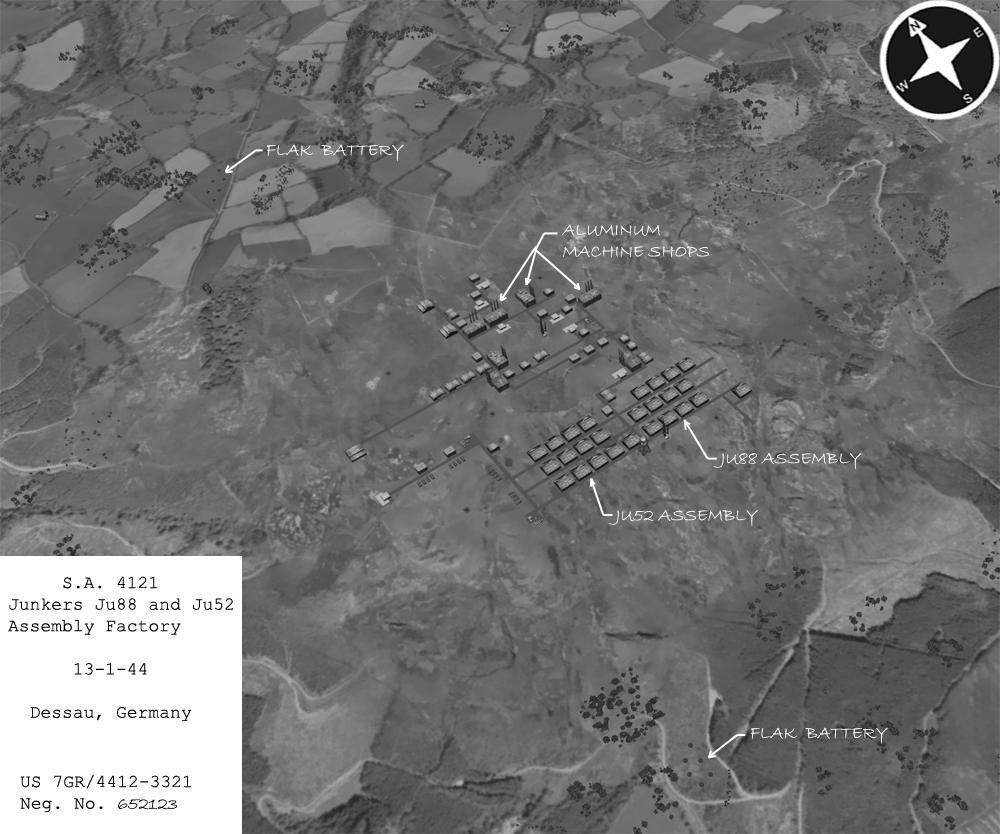
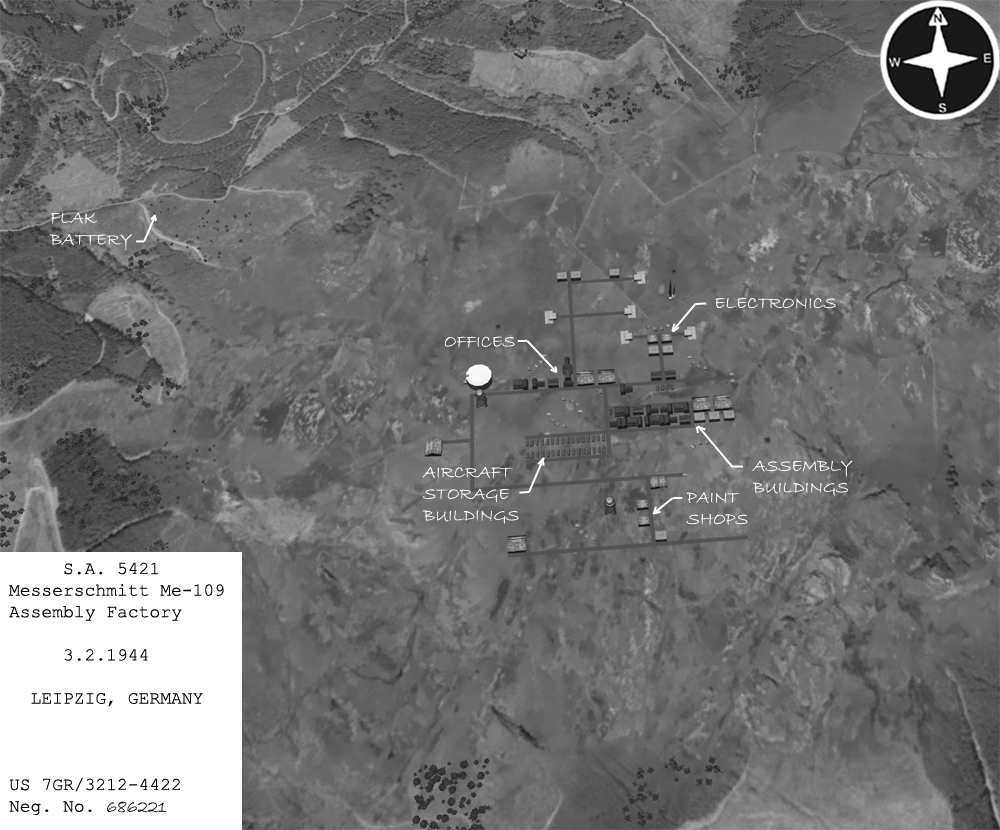
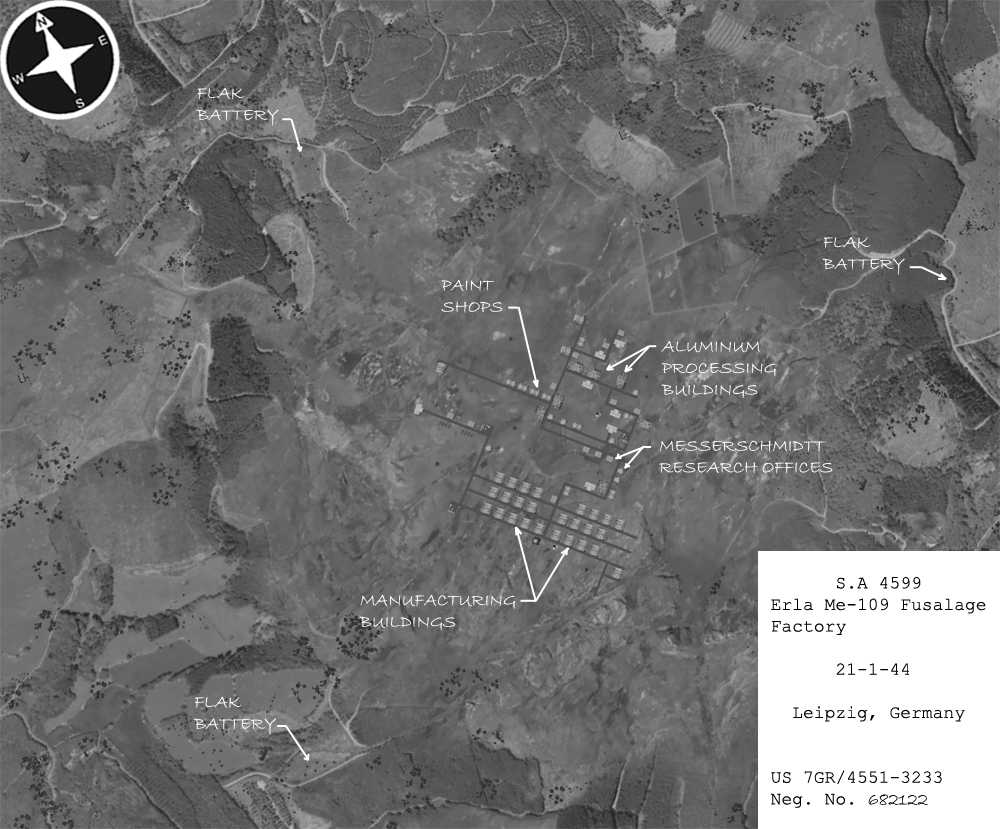

American Active Airspawns:
- A65 South - 5,14,9
- A57 South - 6,12,5
- A59 South - 5,9,5
- A96 South - 5,6,9
Luftwaffe Active Air Bases:
- A5 - Briest
- A6 - Wittstock
- A14 - Brandis
- A16 - Alberstedt
- A19 - Stade
- A36 - Paderborn
- A44 - Nidda
- A69 - Hannover
- A72 - Kassel
- A98 - Juterbog
Frame 1 Map
Frame 2:
March 6, 1944 - The Big "B"
Berlin, in 1939 it had a population of 4,300,000 and was the greatest industrial and commercial center in Europe. Within it's city limits are prime military targets, it is the capital and administrative center of the Reich and the hub of Germany's war effort. By 1944 the city was devoted to war production. Its factories contain half of the electrical industry making items from ignitions to radios and radar sets. Berlin is also a center of aircraft production. Heinkel has a factory at Oranienburg churning out 26 HE-177 bombers per month. Another Heinkel factory in Johannisthal is building Henschel 129 attack aircraft and Ju-88 medium bombers. Most of the other aircraft manufacturers have component factories in the city's limits churning out items for numerous other aircraft. The Argus works in Reinickendorf is making pulse jet engines for the V-1 flying bomb. Daimler-Benz has an engine factory in the southern portion of the city, which turns out a fifth of the total engine production for Germany. Berlin is also the next largest manufacturer of ball bearings behind Schweinfurt. Other factories are mass-produced tanks, self propelled guns, trucks and other vehicles as well as the engines to power them.
Up until March 1944 Berlin's location 550 miles from the bomber and fighter bases in England had kept it safe from attacks by day. A large portion of the capital's citizens are of the belief that this distance and the defenses of the Luftwaffe and flak batteries would continue to keep the city safe from daylight attack. The flak batteries around Berlin are under the command of the 1st Flak Division 78 heavy batteries with 414 guns containing 88 mm, 105 mm and 128 mm weapons capable of reaching bombers at any altitude. Also within the city's defenses are 14 lighter batteries containing 331 automatic weapons.
By March 1944 the Eighth Air Force was ready for the challenge of reaching and bombing Berlin. There were three very good reasons for making the attack. First any damage inflicted on the targets arrayed in and around Berlin would harm the German war effort. Secondly the attack would be a psychological blow to the population of Berlin with the knowledge that Berlin was no longer safe and could be attacked whenever desired. And lastly that the Luftwaffe would be obliged to respond to an attack on Berlin with everything in its inventory there by exposing them to destruction.
Berlin had been the target of raids on March 3 and March 4 1944. both times the attacks had been foiled by weather which broke up the formations of bombers prompting a recall. On March 4, 1944 one bomber formation with elements of the 95th and 100th Bomb Groups either ignored or didn't hear the recall and in concert with a small fighter escort bombed the city using radar through the clouds. Minor damage only was caused by this effort. March 5th's weather was likewise lousy and the main attack was rescheduled for March 6, 1944.
American Strategic Targets:
- Berlin - Sector 16,13,8
VKF Ball Bearing Works, Erkner - 16,13,8,1
Robert Bosch Electrical Works, Klein Machnow - 16,13,7,3
Daimler-Benz Aero Engine Works, Genshagen - 16,13,5,7
American Active Airspawns:
- A61 South - 7,18,6
- A65 South - 5,14,9
- A57 South - 6,12,5
- A59 South - 5,9,5
Luftwaffe Active Air Bases:
- A2 - Werneuchen
- A4 - BorkHeide
- A5 - Briest
- A6 - Wittstock
- A7 - Parchim
- A8 - Greifswald
- A16 - Alberstedt
- A19 - Stade
- A36 - Paderborn
- A69 - Hannover
- A72 - Kassel r
- A98 - Juterbog
Frame 2 Map
Frame 3:
May 28, 1944 - Öl ist der Lebenssaft
In early March a psychological turning point in the war over Germany had been reached. Berlin, the capital of the Reich was struck by 8th Air Force bombers three times starting on March 6, 1944. General Spaatz now wanted to continue to Operation Pointblank directive and launch his 8th and 15th Air Force bombers against refineries and plants in an oil campaign. Oil refineries and synthetic oil plants were compact easily bombed targets which would reap great rewards after the upcoming invasion of the continent. Their reduction would effect the ability of the German air force and army to respond after D-Day.
Yet General Eisenhower favored "the transportation plan", which was to send the bombers against the French and Belgium railway system overruled General Spaatz. The plan was to disrupt the ability of the Germans to resupply and reinforce the invasion area. General Spaatz argued that the oil campaign would give the same results but also reduce the Luftwaffe's ability to interfere. On March 25, 1944 Eisenhower chose the transportation plan.
Spaatz who most likely had the future of the Army Air Force doctrine of strategic bombing in mind, chose to ignore this directive whenever possible. In fact he did more than that. By the last week of April not a single attack had been launched against marshalling yards. In fairness it must be noted that a majority of the strikes had been diverted to attack the "No Ball" targets which were sprouting along the channel coast. These sites were the launch facilities for the V-1 Vengeance weapons which posed a danger to the forces assembling for the invasion.
Meanwhile Spaatz had talked to Eisenhower and gotten him to agreed to two chances with good visual bombing weather to prove his point with the oil campaign. In response Spaatz launched on April 22 an 800 bomber raid against the marshalling yards at Hamm , the largest rail yard in Germany. Weather was to be a problem and it was three weeks before clear weather over the oil targets. On May 12 900 bombers and 735 fighters attacked targets at Merseburg, Lutzkendorf, Zeitz, Brux and Bohlen. The reaction from the Luftwaffe was fierce. In fact the largest day-fighter force ever had been put up and command and control proceedures worked perfectly. Yet the bombers could not be stopped. Damage inflicted on the refineries was tremendous and the losses to the bomber force was likewise severe. Yet after the war Albert Speer, German Minister of Armaments, said "This day marked the end of German Armament."
The May 12 raid was successful, and this was confirmed by an Ultra intercept which ordered a reduction in non-operational flying for the Luftwaffe. Stocks of fuel begain to fall including that which had been built up for the forthcoming invasion. In response the Germans took measures to improve the air defense, camouflage and smoke defenses around these and similar facilities. Weather over the continent continued to be a problem. It was May 28 before the meteorologists promised good visual bombing weather again. This would allow the second opportunity to prove the oil campaign and the night before teletypes chattered all over England calling for a maximum effort.
American Strategic Targets:
- Dessau - Sector 14,12,2
- Magdeburg - Sector 13,12,8
- Leipzig - Sector 14,10,9
- Brunswick - Sector 11,13,6
Junkers Flugzeug un Motorenwerk A.G - 14,12,2,4
I.G. Farbenindustrie A.G. Plant - 13,12,8,8
Braunkohle-Benzin A.G. Oil Refinery - 13,12,7,9
Wintershall A.G. Oil Refinery - 14,10,9,5
MIAG Armored Vehicle Plant - 11,13,5,3
Photo Recon of Targets:

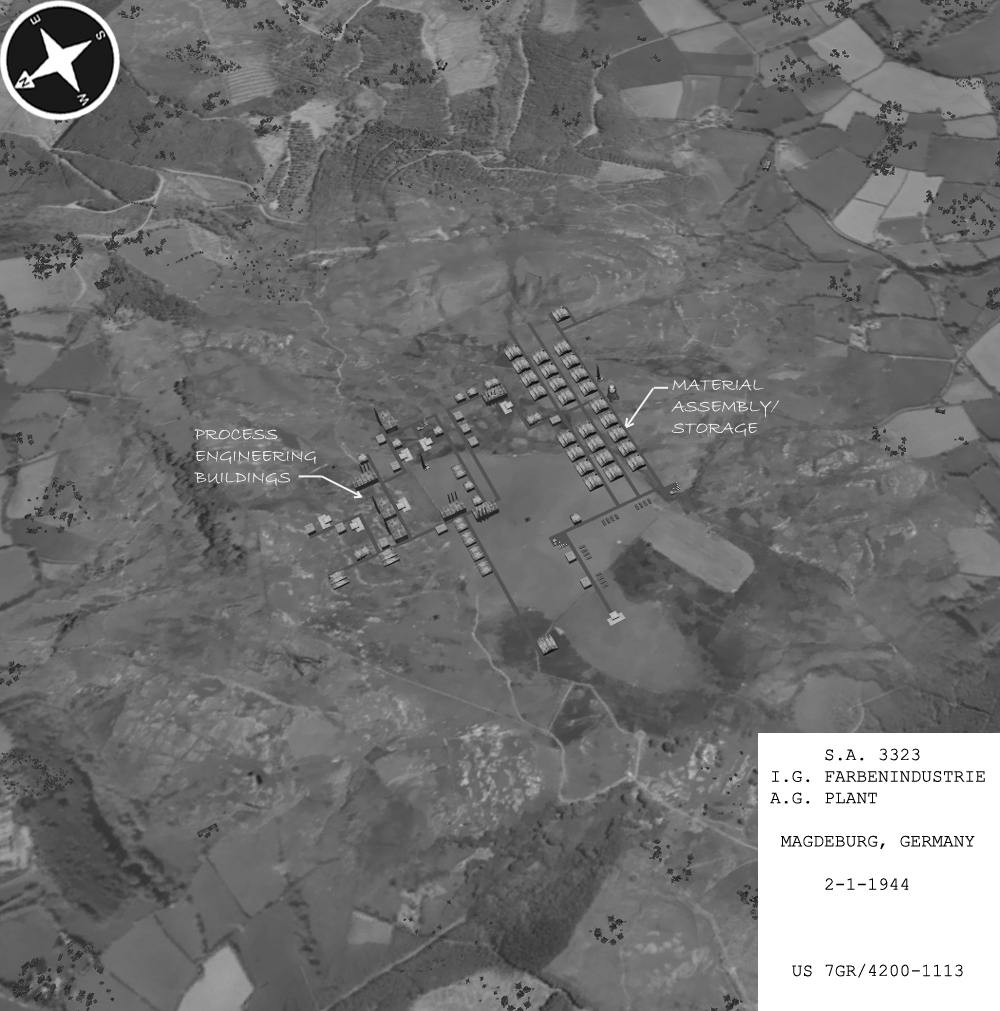

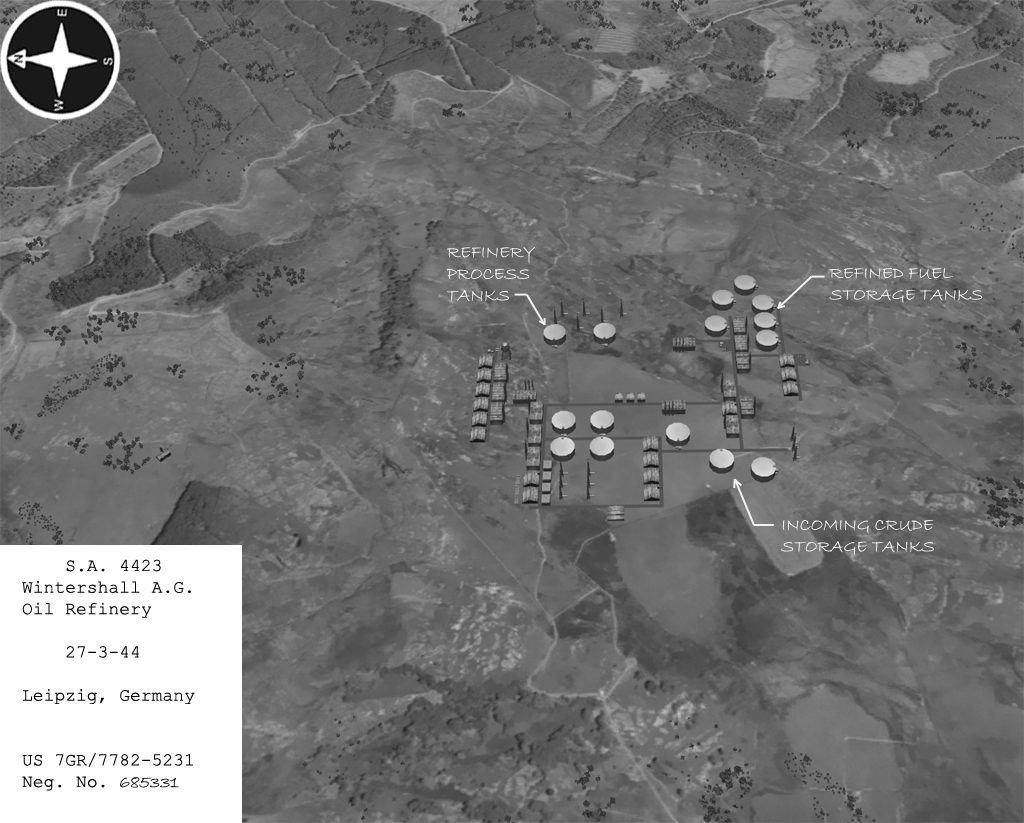

American Active Airspawns:
- A61 South - 7,18,6
- A65 South - 5,14,9
- A59 South - 5,9,5
- A96 South - 5,6,9
Luftwaffe Active Air Bases:
- A4 - BorkHeide
- A5 - Briest
- A8 - Greifswald
- A15 - Lobnitz
- A16 - Alberstedt
- A18 - Alberstedt
- A19 - Stade
- A32 - Gutersloh
- A36 - Paderborn
- A44 - Nidda
- A69 - Hannover
- A72 - Kassel
Frame 3 Map
Frame 4:
July 21, 1944 - Ball Bearings and Messerschmitts
The southern German city of Schweinfurt was the center of ball bearing manufactory for the German war machine. An estimated 2.4 millions ball bearings were used in the war industries per month. Schweinfurt accounted for roughly 40 percent of the total output of the ball bearing industry. Twice in 1943 the Eighth had sortied into southern Germany beyond the reach of its escorting fighters. The August 17 mission was to cost 24 bombers on the Schweinfurt force and an additional 36 from the force sent against the Messerschmitt complex at Regensburg. Yet production dropped 38 percent from pre-raid levels.
On October 14, 1943 a second mission was sent to this vital target. Again losses were heavy with 60 bombers not returning to England and a further 22 lost on landing or damaged beyond repair. However the production at the ball bearing facilities dropped 67 percent. The analysis was that the attacks on the industry must continue. Three reasons were given for this.
- 1. Attacks on bearing plants offered the possibilities of cutting across German industry and, with the limited forces available, affecting output of items not easily reached by direct aerial attacks.
- 2. Production was concentrated in small number of plants readily accessible to Allied bombers.
- 3. The industry used a great deal of highly specialized machinery difficult to replace and vulnerable to fire and high explosives.
So the attacks continued even after the horrific losses. Yet the Eighth Air Force did not return to Schweinfurt until February 1944, when long range escorts became available. The Messerschmitt fighter industry was centered around Regensburg although dispersal of the production and assembly of the fighters had occurred, the main factories were still worthy targets.
American Strategic Targets:
- Schweinfurt - 11,7,8
- Stuttgart - 9,4,6
- Regensburg - 14,5,2
- Munich - 13,2,4
Kugelfischer Ball Bearing Factory - 11,7,8,8
VKF Ball Bearing Factory - 11,7,8,6
Damlier-Benz DB-601 Engine Factory - 9,4,6,2
Messerschmitt Me-109 Components - 14,5,2,2
Messerschmitt Me-109 Components - 14,5,2,5
Metzler Rubber Fabrication Plant - 13,2,4,9
Photo Recon of Targets:


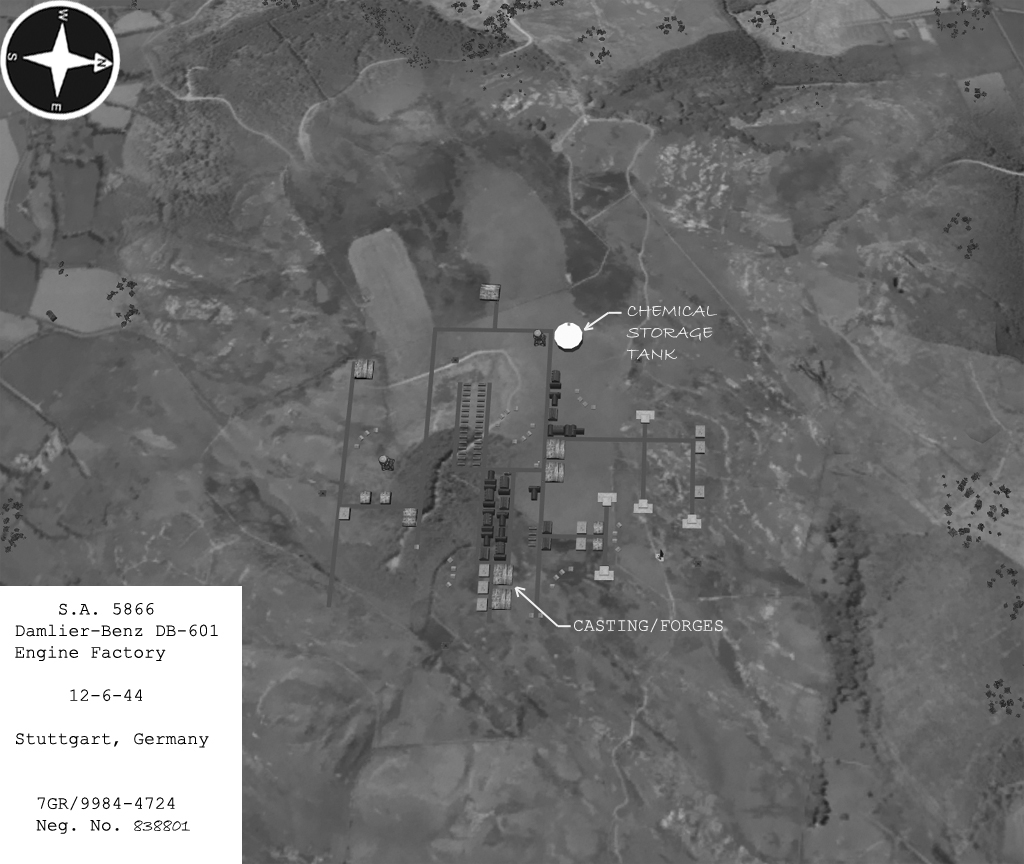
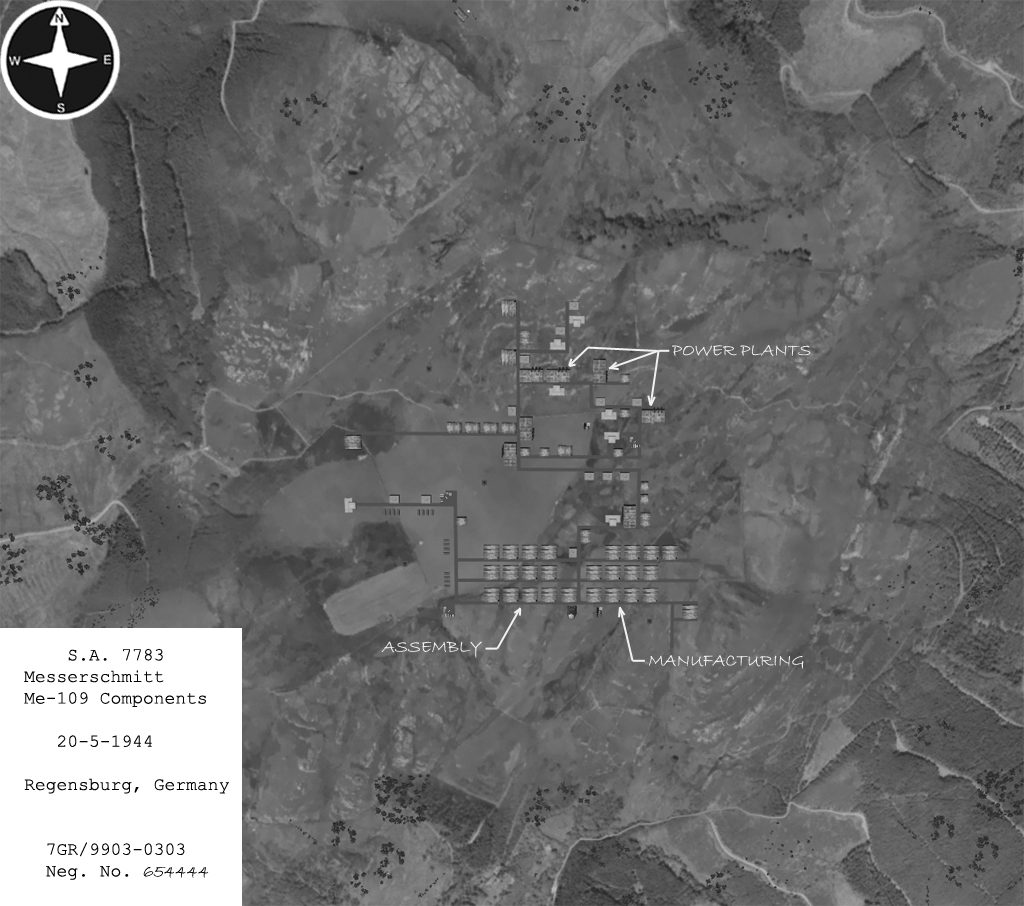


American Active Airspawns:
- A1 South - 2,14,1
- A57 South - 6,12,5
- A59 South - 5,9,5
Luftwaffe Active Air Bases:
- A44 - Nidda
- A46 - Frankfurt
- A47 - Kirrlach
- A48 - Giebelstadt
- A49 - Kitzingen
- A50 - Schwabisch Hall
- A53 - St-Echierdingen
- A55 - Neubiberg
- A72 - Kassel
- A83 - Nuremberg
Frame 4 Map
Frame 5:
November 2, 1944 - Der Grosse Schlagg
During September and October 1944 the armies on the eastern and western fronts advancing on Germany have ground to a halt. Both fronts had seen huge gains in territory in the last months. This success had led to the outstripping of supply lines so the operational tempo slowed on the ground. This reduction in ground operations allowed the Luftwaffe to reduce it's own operations to the bare minimum, except for sorties in defense of Germany proper.
The German aircraft industry had reorganized and in September produced 3,821 new combat aircraft. Four out of five of these aircraft were Messerschmitt 109s and Fw 190s. This increase in production produced an excess of aircraft in the frontline units. All 15 Gruppen deployed in France had suffered heavy losses. They were completely re-equipped with the influx of new production aircraft. There was also a simultaneous expansion of the single-engined day fighter Gruppen from 1900 aircraft to 3000 by the middle of November. Each day fighter Gruppe in the west expanded from three to four Stafflen, each with 10 to 16 aircraft. This recovery and increase in fighters was to come as a surprise to the Allies.
The Gruppen on the western front fell back across the Rhine to bases in Germany. Also several units where pulled back from the Eastern front and the Balkans into the Reich. These units were reequipped with the new production aircraft and brought back to strength with replacement pilots who had been given specialist training in attacking bombers. However the combat of the past year had severely depleted the pool of experienced leaders. Only a few of the best leaders are left after the hectic combat of the winter of 44 and the slaughter over France after the invasion. These were a valuable asset not to be risked lightly.
Generalleutnant Adolf Galland was thus presented with a force reinvigorated and ready to strike a decisive blow against the allied bombing offensive. On the morning of November 2, 1944 there were 30 oeprational Gruppen of day fighters avaiable with a further 16 refitting or training, totalling a force of some 695 aircraft.
Some of the best Gruppen of the Jagdwaffe have been brought together in order to deliver the "Grosse Schlag" or Great Blow. On October 26, 1944 Reichmarshall Goering called a meeting at his headquarters in Berlin. All formation leaders down to and including Gruppenkommandeure and a Staffelkapitan from each Gruppe were in attendance. At the conclusion of the meeting Goering announced "I want 500 B-17s brought down next time or I'll have you transferred to the infantry!"
The Jagdwaffe had it's orders. A maximum effort was to be exerted on the next Allied bomber attack. Galland's challenge was to inflict such losses on the Allied bombers and fighters that they were forced to stop their ongoing offensive against the infrastructure of Germany while not crippling the Jagdwaffe and loosing the last of his remaining leadership.
It is business as usual in East Anglia, with missions being planned based upon weather. The targeting of the synthetic oil installations, refineries, marshalling yards, and selected airfields continues unabated. Strong enemy resistance in the form of a large intercept of the bombers in early and late September had forewarned the leadership of the 8th Air Force that something was brewing. The almost complete absence of the Luftwaffe in October further heightened this worry. General Doolittle and his staff were well aware that if a concentrated force of German fighters broke through the escorts as many as 100 bombers could be destroyed. A loss of 10% of the bomber force would weaken the continuation of "Operation Pointblank". A repeat of such an event would most certainly bring about the cessation of daylight bombing.
American Strategic Targets:
- Magdeburg - Sector 13,12,8
- Leipzig / Merseburg - Sector 14,10,9
- Gotha - Sector 12,10,1
- Zeitz - Sector 15,9,8
Rothensee Jumo Engine Factory - 13,12,8,8
Braunkohle-Benzin A.G. Oil Refinery - 13,12,7,9
I.G. Fabenindustrie Synthetic Oil Refingery - 14,10,9,5
Gothaer Waggonfabrik - Sector 12,10,1,9
Braunkohle Benzin Synthetic Oil Plant - 15,9,8,1
Photo Recon of Targets:


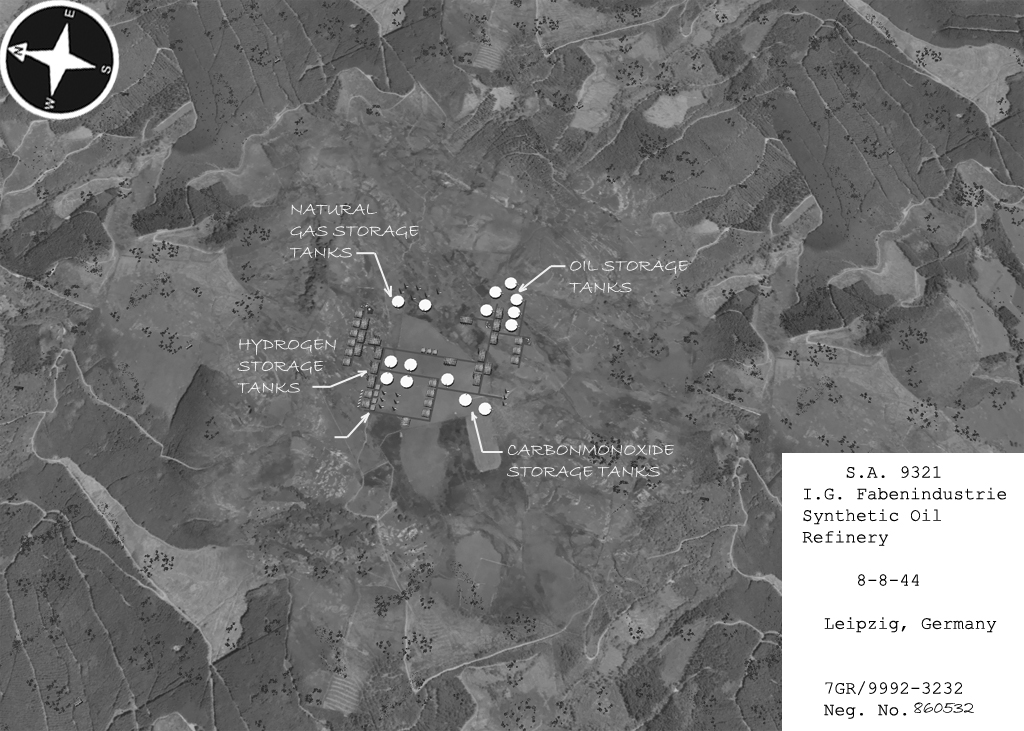
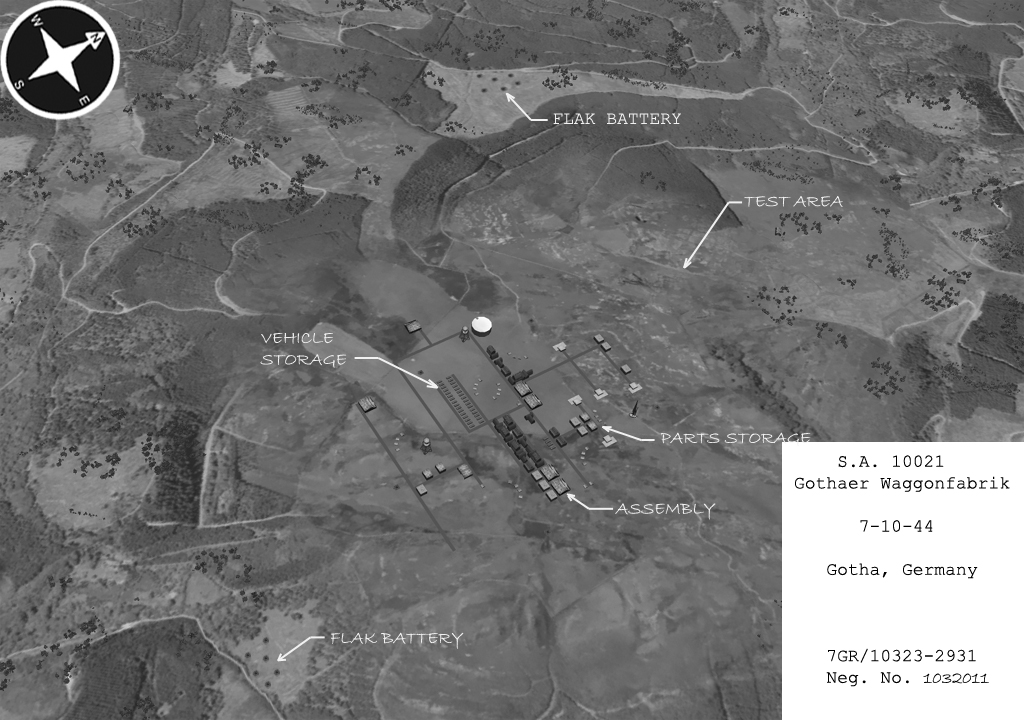
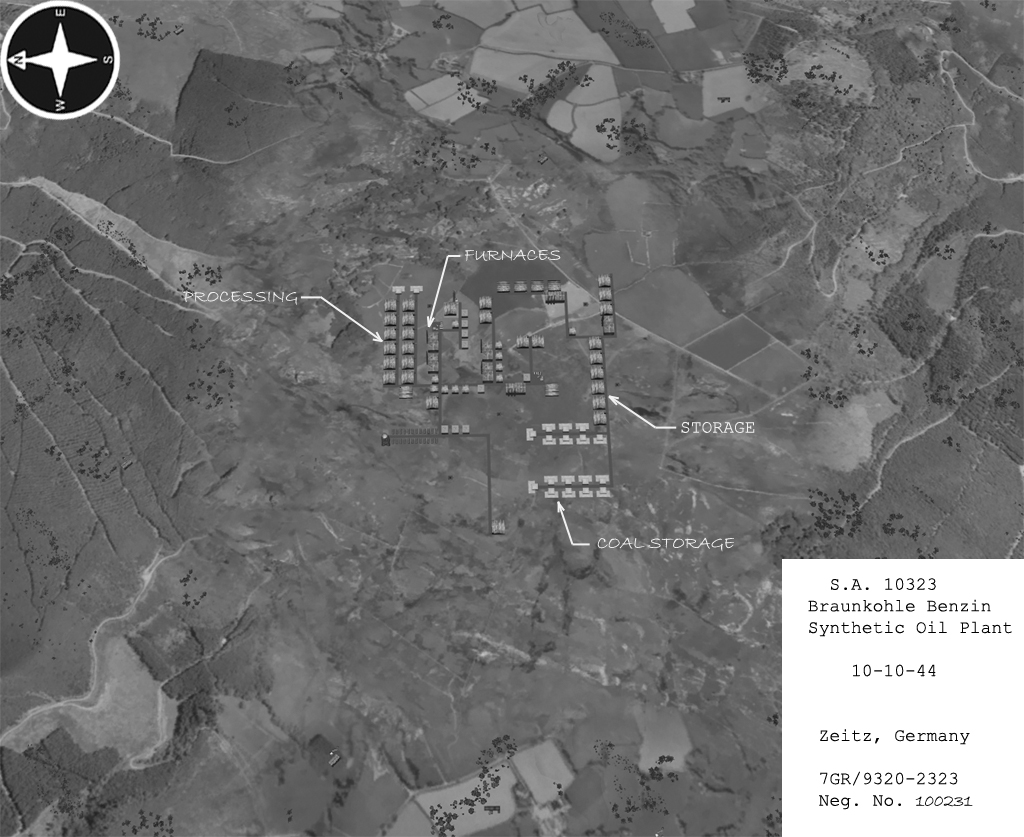
American Active Airspawns:
- A65 South - 5,14,9
- A57 South - 6,12,5
- A59 South - 5,9,5
Luftwaffe Active Air Bases:
- A4 - BorkHeide
- A5 - Briest
- A8 - Greifswald
- A14 - Brandis
- A15 - Lobnitz
- A16 - Alberstedt
- A19 - Stade
- A36 - Paderborn
- A44 - Nidda
- A69 - Hannover
- A72 - Kassel
Frame 5 Map
Frame 6:
April 7, 1945 - Kights des Himmels
The Allies are across the Rhine River, the last natural defense of the western approaches to Germany. From the east the Red Army is at the Oder River and preparing for a lunge toward Berlin. In the skys tactical air forces from both fronts range over Germany. At night the RAF continue to bomb cities in massive raids. During the day the Eighth Air Force continues to attack the infrastructure of the Reich. Refugees flood the roads fleeing from the oncoming Soviet armies to the west.
The Luftwaffe fights on, new units and old are equiped with some of the long promised aircraft that have become available. The JadgGeschwader suffer from crushing fuel shortages, they forced to use oxen to relocate aircraft on the ground to save every last drop of aviation fuel for flight. The pilots are a few old experten who lead barely trained jagdflieger against the vast numbers of allied aircraft. With the cities bare shells of themselves, famine, and destruction from the channel coast to Moscow the war continues.
The Luftwaffe fights on, the Knights of the Sky still rise to defend the cities and people of the Fatherland. As the controllers again broadcast from their control bunkers, the speakers at airfields scattered across the remaining portions of the Reich say the familiar words, "Achtung an alle! achtung an all! Dicken Autos im sektor Dora Dora!"
American Strategic Targets:
- Magdeburg - Sector 13,12,8
- Berlin - Sector 16,13,8
- Rostock - Sector 14,18,5
Braunkohle Benzin Synthetic Fuel Plant - 13,12,7,9
Krupp Crusonwerke Panzer Factory - 13,12,8,6
Hennschel He162 Assembly - 16,13,7,6
City Complex - 16,13,8,1
Heinkel Aircraft Assembly - 14,18,2,5
American Active Airspawns:
- A61 South - 6,19,1
- A65 South - 5,14,9
- A57 South - 6,12,5
- A59 South - 5,9,5
Luftwaffe Active Air Bases:
- A2 - Werneuchen
- A5 - Briest
- A6 - Wittstock
- A7 - Parchim
- A8 - Greifswald
- A9 - Sachau
- A16 - Alberstedt
- A17 - Lubeck-Blankensee
- A18 - Kaltienichen
- A98 - Juterbog
Frame 6 Map
Settings
Weather: Weather might be varied with heavy cloud banks at times mixed at medium and high altitude. Weather blocking targets is possible with heavy clouds at varying altitudes.
Terrain:GERMANY
Wind: 0 mph at 0-5k altitude, 5 to 15 mph from one direction on up. Will vary by frame.
Radar and Sector Counters: For the Axis - enemy sector counters will show when a plane is within 50 miles of radar towers and above 1500 ft, friendly counters will not be visable. For the Allies - no sector counters will be visable. For All - Planes above 34,000 ft will show as dots on radar when in 50 miles of radar towers. Radar updates every 4 minutes.
Destroyed Objects: All objects, once destroyed, stay destroyed the whole frame. All objects will respawn at the start of the next frame. Also note hardness of various objects below.
Auto Acks: Greatly reduced lethality, including for "puffy" ack. See setting below, where 1.0 is normal in Main Arena.
| Variable | Default Value | Explanation of Variable |
| Arena Flags | Locked 141 - Unlocked 140 | Lock Arena, Kill Shooter, Perk Disabled, Ditch scores kill. |
| BomberWarningRange | 63,360 (12 miles) | A base starts flashing when an enemy bomber gets within this number of feet. |
| CommunicationFlags | 3 | Various communication flags. |
| DeathMaxCount | 0 | After this many deaths, you have to wait DeathTimeMin before spawning the next time. |
| DeathTimeMin | 0 | How long in minutes you have to wait before spawning after DeathMaxCount deaths. |
| DownTimeMult | 6.0000 | A multiplier for down time of objects. For example, if Bunk Ammo has a Down Time of X and if DownTimeMult = Y, the actual down time for Bunk Ammo is X*Y minutes. |
| EnemyIconRange | 9000 (3k) | Enemy icon range in feet (9000 = previous .icon 1). |
| EnemyLowIconRange | 9000 (3k) | Has to do with icon range when altitude is low. |
| ExitWhileMoving | 460 | Various flags on whether or not a player can exit whilemoving. |
| FighterWarningRange | 31,680 (6 miles) | A base starts flashing when an enemy fighter gets within this number of feet. |
| FogVisibilityMiles | 17.00 | Visibility in miles. |
| FriendlyIconRange | 15,000 (5k) | Friendly icon range in feet. |
| FuelBurnRateMult | 0.8 for Frames 1 and 2, 1.0 for the rest. | See Designers Notes for explaination of fuel settings. |
| GroundAutoLethality[Armored] | 0.10 | See "GroundAutoLethality" section. |
| GroundAutoLethality[Hard] | 0.10 | See "GroundAutoLethality" section. |
| GroundAutoLethality[Soft] | 0.10 | See "GroundAutoLethality" section. |
| KillShooter | 1 - Note this is different than usual. | If this is 1, you take the damage if you shoot a countryman. If this is 0, he takes the damage. |
| PerkPointsDisabled | 1 | 1 if awarding of perk points for kills is disabled. 0 if it is enabled. |
| PlayerResupplyTime | 0 | Minutes of downtime subtracted from down objects when supplies are dropped at a base. |
| RadarAlt | 34,000 | If a plane is under this altitude, it won't show on dot radar (unless full friendly or full enemy is selected). |
| RadarMode[Bishops] | 48 | Disable friendly and enemy ranged based counters. |
| RadarMode[Knights] | 336 | Range Based Counter, Plane Counters Only, Disable Friendly Counters. |
| RadarMode[Rooks] | 48 | Various flags for setting radar attributes. |
| RadarUpdateRate | 240 | Radar updates every 4 minutes. |
| RandomRotate | 0 | Whether or not a Country Reset rotates countries randomly. |
| ResetAirFieldCnt | 1 | If a country has less than this many airfields, the war is won, and the arena does a reset. |
| ResetTotalFieldCnt | 1 | If a country has less than this many total fields, the war is won, and the arena does a reset. |
| SectorCounterAlt | 1500 | If a plane is under this altitude, it's won't show in the sector counters. |
| SectorCounterRange | 264,000 (50 miles) | If RadarMode is set to have Range Based Counters, this is the range in feet from the radar station that a plane has to be in order to show in the sector counters. |
| StratFlags | 1 | Disable strat supply. |
| TowerBasedRadarRange | 264,000 (50 miles) | The range in feet from a radar station for dots to appear on the radar display (unless full friendly or full enemy is selected). |
| VehicleWarningRange | 15840 | A base starts flashing when an enemy vehicle gets within this number of feet. |
| ViewModeFlags | 2 | Various flags for view. |
Note in the object settings below, "Down Time" is not the actual down time in minutes. Actual down time in minutes is "Down Time" times DownTimeMult given in the above table.
| Object Name | Down Time | Hardness (1000 lb) | Explanation |
| Bomb Hgr | 1 | 100 | Bomber hangar nearly indestructible. (Down time) * DownTimeMult = 6 minutes |
| Bunk Ammo | 1 | 100 | Ammo bunker nearly indestructible. (Down time) * DownTimeMult = 6 minutes |
| Bunk Fuel | 1 | 100 | Fuel bunker nearly indestructible.(Down time) * DownTimeMult = 6 minutes |
| Bunk Radar | 1 | 100 | Radar tower nearly indestructible. (Down time) * DownTimeMult = 6 minutes |
| Ftr Hgr | 1 | 100 | Fighter hangar nearly indestructible. (Down time) * DownTimeMult = 6 minutes |
| Town | -- | 1000 | Town buildings nearly indestructible. |
All other settings are the default settings listed here: http://ahevents.org/images/stories/scenarios_images/defaultSettingDocument/defaultArenaSettings.html
For CM's:
CM Reference
MOTD. The following can be copy and pasted to use as the MOTD, with appropriate number for frame number.
Welcome to the scenario "Battle Over Germany"!
Show up at or before 9:30 pm Eastern Time to play.
If you are not registered, you are welcome to play,
but please change to country Rook,
go to [], and type on channel 200,
"Walkon requesting assignment."
If you need back in and the arena is locked, please
enter ".p roc let me in" into a radio text buffer
such as from the Main Arena. Try getting into the
arena thereafter even if the games says the arena
is locked -- the screen doesn't update quickly.
Once in, type ".p roc i'm in".
Allies = Bishops
Axis = Knights
walkons = Rook
CM checklist. Prior to Show-Up Time:
- Announce to players to remind CM if he doesn't announce "logs started".
- Load terrain.
- Rotate countries if needed. Make sure axis fields are Knight, allied fields are Bishop.
- Load tables.
- Change field ownership if needed.
- Set MOTD.
- Check that correct planes are enabled at correct fields -- make sure ground guns are enabled everywhere. Save if any changes done.
- Check arena variables and resave all the non-default ones. Save if any changes done.
- Set object settings.
- Destroy any objects needed.
- Set .icon.
- Set wind.
- Remember to do .startlog before takeoffs.
- Get walkon field number for axis and allies.
- Remember ".vset arenaflags 0" unlocks arena.
Timing Table
| Event | Real Time | Tower Clock | Event tasks |
|
S (Show-Up Time) |
9:30 pm Eastern, 6:30pm Pacific | 8:30 |
|
| S+20 |
| ||
| S+25 = T-5 (Takeoff Countdown) |
| ||
|
T-0 (Takeoff) |
10:00 pm ET, 7:00 pm PT | 9:00 |
|
| T+3 hours | 1:00 am ET, 10:00 pm PT | 16:30 |
|
| T+3.5 hours (Frame End) | 1:30 am ET, 10:30 pm PT | 17:45 |
|
| T+3.5 hours (End Log) | 1:30 am ET, 10:30 pm PT |
|
References
- The Mighty Eighth by Roger A. Freeman
- The Mighty Eighth War Manual by Roger A. Freeman
- The Mighty Eighth War Diary by Roger A. Freeman
- On the Highways of the Skies The 8th Air Force in World War II by Martin W. Bowman
- Battles with the Luftwaffe The Bomber Campaign Against Germany 1942-45 by Theo Boiten and Martin Bowman
- Mission 376 Battle Over the Reich by Ivo de Jong
- Target Berlin Mission 250: 6 March 1944 by Jeffrey L. Ethell and Alfred Price
- The Luftwaffe over Germany Defense of the Reich by Donald Caldwell and Richard Muller
- I Flew for the Fuhrer by Heinz Knoke
- Jagdegeschwader 301/302 "Wilde Sau" In Defense of the Reich with the Bf 109, Fw 190 and Ta 152 by Willi Reschke
- Jagdwaffe Volume 5 Section 3 Defending the Reich 1944-45 by Robert Forsyth
Designer Historical Notes:
With each scenario we balance play and the planeset to bring to you historical battles. In this scenario there are a few things which do not line up with history.
Credits
Scenario design: Fencer
Terrain: 68Falcon
Scenario CM's: Brooke (Team Lead), ROC and Fencer.
Allied CO: To Be Determined
Axis CO: To Be Determined
Special Thanks to the following for their input; Have, Nefarious, Easyscor, and 4440.

